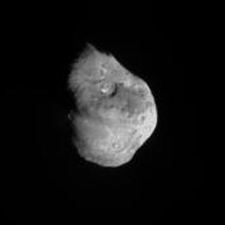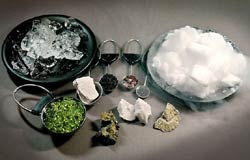Deep Impact Revisted
By David Tytell
September 9, 2005

|
|
This highly processed image of Comet Tempel 1 shows the initial debris after
the spacecraft's impactor collided with the nucleus. The ejected dust shrouded
the mothership's view of the resulting impact crater.
Courtesy NASA / JPL / Caltech / University of Maryland.
| | | | |
| |
It has been two months since the Deep Impact spacecraft's impactor slammed into Comet Tempel 1, and astronomers are continuing to learn about the physics of the event, the nature of the excavated debris, and how the experiment's results are changing what they know about comets and the early solar-system conditions in which these ancient relics formed.
In a full day of presentations at this week's American Astronomical Society Division for Planetary Sciences meeting in Cambridge, England, scientists from around the world discussed their latest findings. Here are some highlights:
In the weeks before the impact, Comet Tempel 1 experienced a series of six eruptions; two of these occurred a week before impact. Most of the outbursts seemed to come from the same area of the comet's surface when it was near local sunrise. The comet retains very little heat, so the team speculates that the outbursts might be due to volatile compounds near the surface.
The impactor craft was rattled by four dust grains in the last 21 seconds before impact. The first three had masses of less than 10 milligrams (0.0004 ounce). But the last hit, occurring three seconds before impact, was by a 0.9-gram (0.03-ounce) dust pebble. The collisions didn't send the craft off course, but they did cause the shaky images seen in the impact-approach movie.
Pictures of the comet helped team members derived a shape model of its nucleus. Tempel 1's newly measured size is 7.6 by 4.9 kilometers (4.7 by 3.0 miles). This is notably smaller and rounder than the 14-kilometer-long value assumed by the team before the encounter.

|
|
This image from the impactor's targeting sensor shows the nucleus of Comet
Tempel 1 six minutes before the collision. The large impact crater above the
comet's center is the first such structure seen on a cometary nucleus.
Courtesy NASA / JPL / Caltech / University of Maryland.
| | | | |
| |
In the past few years spacecraft have visited three Jupiter-family comets: Borrelly, Wild 2, and Tempel 1. Their nuclei appear vastly different when seen up close. For example, Tempel 1 and Wild 2 both sport round features on their surfaces. But Wild 2's round regions are attributed to sinkholes or spots where ices vaporized. By contrast, the Deep Impact team claims it has observed the first impact craters ever seen on a comet. Tempel 1's round features have raised rims and sloping walls (unlike Wild 2). "Geologists are convinced that there is nothing on [Tempel 1] that suggests these are not craters," says Deep Impact science team leader Michael A'Hearn (University of Maryland).
The impactor struck obliquely, which helped to maximize the amount of excavated dust. In total, the collision ejected about 10 million kilograms (11,000 tons) of material from the surface. The impact physics revealed that the comet is held together only by self-gravity rather than by structural bonds between the cometary particles themselves.
The mass of Tempel 1's nucleus is around 72 trillion kilograms. The density is about 0.6 gram per cubic centimeter. That density, along with the gravity-dominated nature of the nucleus, has led team members to conclude that Tempel 1 is a porous rubble pile. This very loose body must be very weakly held together by gravity.
The vast quantity of ejected dust made it very difficult for the mothership's cameras to see through to the impact crater. Some team members think they may have teased out an image of the crater, but more analysis is necessary before it can be conclusively identified. Models based on the measured volume of excavated dust, the porosity, and the comet's gravity suggest that the crater must be about 100 meters (330 feet) across and about 30 meters deep.
The comet's outer layer is dusty fine powder. No blocks or boulders were seen flying from the impact site; only talcum-powder-like debris was observed.
The spectrometer watched the ejecta plume expand outward. The observations revealed a distinctly layered comet. After the first blast of hot gas and plasma shot past the flyby craft's spectrometer, the instrument recorded a large peak due to water ice. "It's the first thing we see after the hot vapor goes past. It must be near the surface," says team member Jessica M. Sunshine (Science Applications International Corporation). The water was soon followed by a strong signal of organic materials.

|
|
This somewhat whimsical photo shows the various ingredients that make up a comet
as identified in spectra of Comet Tempel 1 taken by NASA's Spitzer Space
Telescope. These "comet soup" ingredients are (on plates, from left to right):
ice and dry ice; (in measuring cups, from left to right) olivine, smectite clay,
polycyclic aromatic hydrocarbons, spinel, metallic iron; (on table in the front,
from left to right) the silicate enstatite, the carbonate dolomite, and the iron
sulfide marcasite.
Courtesy NASA / JPL / Caltech / Robert Hurt (SSC).
| | | | |
| |
Many compounds were seen in the spectra, including water, carbon dioxide, hydrogen cyanide, methyl cyanide, and other organic molecules. From afar, the Spitzer Space Telescope saw minerals such as olivine, calcite, iron sulfite, and aluminum oxide. Moreover, Spitzer observed molecules that have never been seen before in comets, such as polycyclic aromatic hydrocarbons. "It was a fantastically rich spectrum," says team member Carey M. Lisse (University of Maryland).
Team members conclude that far too much dust was released for it to have ever been heated by more than a few degrees. That suggests the material excavated by the impact is primordial — representing the original raw materials present when the comet first formed at the beginning of the solar system. "Comets are the dinosaur bones of planet formation," says Lisse.
The observed molecules are giving some experts pause, however. The spectra also show hints that Tempel 1 contains unexpected compounds such as carbonates and clays. By conventional thinking, these materials only form by chemical processing in the presence of liquid water. Thus, it's possible that the comet's ejecta might not have been "primordial" after all. It might have been processed over billions of years. Can carbonates form inside a comet over extremely long time periods without liquid water? Did the comet melt enough for water to form? Future studies may provide answers.
Finally, NASA has not yet funded the proposed follow-up mission for the still-operational Deep Impact craft, a rendezvous with Comet 85P/Boethin in 2008. But A'Hearn hopes to hear later this year about the status of this proposed encounter. After that, the mission's fate remains uncertain. Unfortunately, says A'Hearn, "We don't have enough fuel to get to Tempel 1 again."
| |
©2005 Sky Publishing Corp.
|
|
|
|



